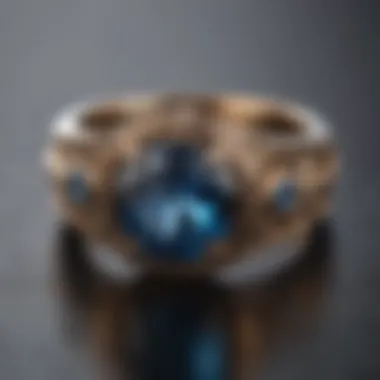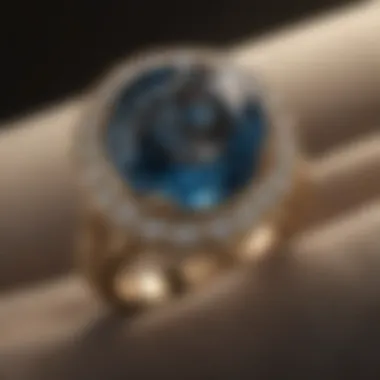Effective Techniques for Ring Resizing


Intro
When it comes to rings, achieving the perfect fit is more than a matter of comfort; it deeply affects the wearer's connection to their jewelry. Imagine slipping on a cherished piece—your grandmother’s heirloom or a wedding ring—and feeling it slide around, or worse, teetering on the brink of slipping off entirely. It's an experience that can cause undue stress.
Sizing rings down to fit just right isn’t just about tightening them up; it’s an art and a science, capturing both the aesthetic and the functional aspects of jewelry design. As we navigate through various methods to tackle the challenge of reducing ring size, we’ll touch upon both professional services and DIY techniques. This overview isn't just a collection of tips but rather a deep dive into ensuring that those precious pieces remain personal and secure, aligning with individual style and comfort.
Preface to Ring Resizing
In the realm of fine jewelry, a well-fitted ring is not just about comfort; it reflects personal style and confidence. The process of resizing rings has become a pivotal element for many when it comes to maintaining the integrity and aesthetics of their cherished pieces. This section aims to set the stage for our comprehensive look at resizing rings, emphasizing the reasons and methods behind it, and examining its significance for various individuals.
Understanding the Need for Resizing
Why might someone feel the urgent itch to resize their ring? Often, it stems from more than just a whim. Life events can influence ring size remarkably; changes in weight, health conditions, or even temperature can cause fingers to swell or shrink.
For instance, consider a person who has fluctuated in weight due to lifestyle changes or pregnancy. Their once-perfectly sized ring now feels tight, potentially causing discomfort or even injury. Similarly, individuals in environments with considerable temperature variations may notice their fingers swell in heat and shrink in cold, leading them to seek a resizing. The need for resizing can serve as an essential reminder of how our bodies and lifestyles are interconnected to the precious items we adorn ourselves with.
Common Reasons for Ring Size Adjustment
A multitude of factors influences why someone may decide to resize their ring; among the key reasons include:
- Physical Changes: A person's body naturally changes over time, whether through weight loss or gain, pregnancy, or aging. These fluctuations can drastically affect how a ring fits.
- Heirloom Preservation: Many families pass down rings through generations. A family heirloom may need resizing for different recipients, ensuring it fits correctly and can be worn proudly.
- Stylistic Preferences: Lifestyle changes or shifts in fashion can lead to a change in how one wants their jewelry to fit. Comfort can often collide with style preferences, prompting adjustments to rings.
- Repairing Damage: Over time, rings can experience stress that may cause them to warp or shrink. Sometimes, even a simple resizing is crucial to restore the ring's integrity after repair work.
"Rings are often more than mere accessories; they capture moments, emotions, and memories. Their fit holds importance akin to their presence."
In sum, resizing a ring is not solely a practical endeavor. It's an emotional, personal journey intertwined with life changes, aesthetic preferences, and family heritage. As we move forward in this article, understanding these motivations will guide our exploration of the practical methods for weeding out size issues effectively and at times, creatively.
This deeper comprehension of resizing rings prevails throughout practical discussions in the following sections. Engaging with both professional and DIY options will equip readers with valuable insights. Whether in search of a quick fix or a more permanent solution, this guide will navigate you through the intricacies of ring resizing with clarity and consideration.
Professional Ring Resizing Options
When it comes to altering a ring's size, professional resizing options stand out as the go-to solutions for ensuring quality and precision. These methods are vital in maintaining the structural integrity and aesthetic appeal of the jewelry. Unlike DIY approaches, which can range from merely adequate to downright risky, professional resizing takes the guesswork out of the equation. Skilled jewelers are trained to handle various materials and designs, making them invaluable for anyone looking to properly resize their rings.
Visiting a Jeweler
The first step in professional ring resizing is often a trip to a jeweler. This might seem straightforward, yet it really is a surefire way to get tailored advice on your individual needs. Jewelers are adept at evaluating the condition of your ring, assessing its materials, and determining the most appropriate resizing method.
Furthermore, an experienced jeweler can advise on the durability of the ring post-resizing. They can identify any additional issues that might not be apparent at a glance—like hidden gems or delicate settings—which can easily go unnoticed by the untrained eye. Ring resizing might seem trivial at first, but having a knowledgeable professional to guide you wraps the process in a layer of reassurance. You wouldn’t want to trust just anyone with such a precious piece, and visiting an expert elevates the chances of a positive outcome.
Types of Professional Resizing Methods


Choosing a professional resizing method involves understanding the available options: soldering and stretching.
Soldering Technique
Soldering is a well-known method in ring resizing, regarded for its efficacy. This technique involves cutting the band, removing a small section, and then using a soldering material to seal the cut. Soldering is generally chosen for its durability and effectiveness in handling various materials, including gold, silver, and platinum. One of its key characteristics is that it provides a clean, seamless finish, restoring the ring's integrity post-resize.
Despite its advantages, there are considerations. For instance, if your ring has intricate designs or a gemstone embedded tightly, the soldering process might cause some disruption that could affect the setting. Thus, it's important to have an experienced jeweler who understands the nuances of your particular piece.
Stretch Method
On the other hand, the stretch method provides a more straightforward resizing approach, as it involves stretching the ring band to increase its size. This method works best for rings made from softer metals that can undergo slight deformities without breaking.
A noteworthy characteristic of the stretching method is that it retains the original design and surface of the ring without altering it fundamentally. The simplicity of this technique, however, does come with risks—especially for rings made from harder metals. If the metal is too dense, attempting to stretch it could lead to cracks or even complete breakage. Therefore, while this method has its advantages of speed and ease, it comes with its own set of caveats.
Evaluating Costs of Professional Services
When considering professional resizing, cost is an important factor. Prices can vary widely based on the method selected, the ring's material, and the jeweler's expertise. Generally, soldering is on the pricier end, given the complexities involved. Stretch methods might be more budget-friendly but should still be approached with caution, considering the potential for further expenses if something goes awry.
DIY Resizing Techniques
Embarking on the journey of ring resizing through DIY techniques can be both empowering and satisfying. These methods not only save on costs associated with professional resizing but can also be a fun project for those who enjoy hands-on tasks. However, a word to the wise: not all rings lend themselves well to at-home modifications, and the potential for error lurks around every corner. Therefore, understanding the ins and outs of DIY resizing is crucial for achieving the desired outcome without compromising the piece's integrity.
Assessing Your Ring and Size
Before diving into the nitty-gritty of resizing your ring, it’s important to start with a thorough assessment. First, ensure that you have the right tools on hand. A ring sizer, or even a simple piece of string can provide a rough measurement. Make sure to measure your ring size at the optimum time, preferably at the end of the day, when fingers are neither too swollen nor too relaxed.
It's also priceless to observe the physical characteristics of your ring. Take note of the metal's type and thickness, as these factors dictate the method you might choose. For instance, heavier bands may require different techniques compared to lighter ones. Consider the design as well; intricately designed rings might harbor more risk in resizing efforts.
Using Ring Reducing Solution
The ring reducing solution, often a lesser-known method, can be surprisingly effective. Typically available at jewelry or craft stores, this solution allows you to apply a shrinking agent designed for metal pieces. The process is rather straightforward: just apply the solution to the inside of the ring and let it set according to the manufacturer's instructions.
Notably, ring reducing solutions are particularly handy when dealing with non-precious metals, such as stainless steel or silver-plated rings. However, it’s worth mentioning that these solutions may not be suitable for all types of metals—do check whether it aligns with your ring’s material to avoid unexpected effects.
Alternative DIY Methods
When DIY ring resizing is on the table, a few alternative methods can come in quite handy. Here we discuss a couple of noteworthy techniques that can make a difference.
Adjustable Ring Guards


Adjustable ring guards are an ingeniously simple solution for those looking to resize their rings. They come designed as bands that fit around the base of the ring, effectively making it smaller by creating an additional barrier. This method enjoys popularity among individuals reluctant to permanently alter their jewelry but needing a quick fix.
One key characteristic of adjustable ring guards is their versatility. They can easily be inserted and removed as necessary, making them an excellent short-term solution. However, a downside to consider is that they may not provide a snug fit for every wearer, especially if one’s fingers vary greatly in size due to temperature changes or time of day.
Temperature Methods
The temperature methods rely on the science behind thermal expansion and contraction. This technique entails cooling down your ring, thereby making it easier to manipulate without risking damage—think of the old saying, "the best-laid plans often go awry."
For instance, in colder conditions, metals contract, allowing for easier adjustments. However, caution is necessary; applying intense heat can warp the structure of certain metals. Therefore, this method is often best used alongside a reliable tool or technique that ensures its effectiveness without risking the ring's integrity.
The advantages of this method include its cost-effectiveness and relatively straightforward execution. But it comes with a disclaimer: it requires a certain level of comfort with handling your jewelry in unusual circumstances. Familiarize yourself fully before proceeding.
Risks and Considerations
Resizing a ring is not just about making it fit; there are numerous factors at play that can impact the structure and aesthetics of your treasured piece. This section delves into the risks and considerations associated with resizing rings. Neglecting these aspects can lead to irreversible damage or a frustrating experience.
Understanding the potential drawbacks can help you navigate the resizing process more effectively, ensuring both the safety of the ring and your peace of mind.
Potential Damage to the Ring
One of the foremost concerns when resizing a ring is the potential for damage. Depending on the method used, materials may suffer stress or deformation. For instance, using a DIY method like stretching can lead to thinning and, ultimately, a break if applied in excess. Fine details, such as engravings or delicate settings, can be compromised as well.
Some common risks include:
- Surface Scratching: Rings can acquire scratches from tools and methods not designed for delicate jewelry.
- Stone Loosening: The resizing process might disturb stone settings, leading to the stones becoming loose, risking loss.
- Structural Weakening: Each resizing, especially when done incorrectly, may weaken the overall structure of a ring, rendering it susceptible to future damage.
For anyone caring for noteworthy pieces—like family heirlooms or valuable collectibles—it's vital to choose your resizing method wisely.
Choosing a Method Based on Material
Each ring is as unique as its owner, and the material of a ring plays a crucial role in determining which resizing method to use. Some materials handle resizing better than others, while some materials may be entirely unsuitable for certain techniques.
For example:
- Gold is quite malleable, making both stretching and soldering feasible.
- Platinum, while durable, can be more challenging to resize. It requires skilled handling.
- Titanium and ceramic rings typically do not resize well due to the material composition, often necessitating replacement instead.
Being mindful of the material can save you from potential mishaps and ensure that your jewelry remains intact and beautiful throughout the resizing journey.
Importance of Professional Help


Ultimately, the importance of seeking professional help cannot be overstated. While DIY options and tricks may sound appealing, especially for those eager to save a buck, the expertise offered by a skilled jeweler is invaluable.
A trained professional understands the nuances of different materials and methods. They can:
- Evaluate the Ring's Integrity: A jeweler can assess whether your ring is suitable for resizing and determine the safest method.
- Prevent Damage: With the right tools and experience, jewelers can minimize the risk of damage that might occur during resizing.
- Ensure Quality Finish: Professionals often have access to advanced tools that result in a more polished and seamless resizing job.
Maintaining Ring Integrity Post-Resizing
Maintaining the integrity of a ring after resizing is critical for both aesthetics and functionality. Many people might think that resizing is a one-and-done deal, but in actuality, it’s just the beginning of a relationship with the piece of jewelry that now carries a new fit. The process of resizing often results in changes to the metal's structure and attributes, making post-resizing care even more significant.
To ensure your resized ring stands the test of time, it’s essential to approach its maintenance with the same level of thoughtfulness that went into its resizing. Proper care not only enhances the ring's appearance but also safeguards the craftsmanship that went into resizing, ensuring that your jewelry remains stunning and resilient for years to come.
Caring for Your Resized Ring
Proper care for your resized ring can mean the difference between it being a cherished piece and a cause for concern.
- Regular Cleaning: Clean your resized ring regularly, but be gentle. Use a soft cloth and warm, soapy water. Avoid harsh chemicals, as they might compromise the resized area.
- Avoid Harsh Conditions: Taking extra caution during activities like sports or manual labor is wise. These activities can subject your ring to impacts that may weaken the resize joint.
- Professional Inspections: Consider having your resized ring inspected by a jeweler periodically. Experts can assess the integrity of the resizing and catch any issues before they worsen.
The goal here is to treat your ring delicately, allowing it not just to look good, but to live up to its legacy.
Understanding Metal Fatigue
Metal fatigue can sound intimidating, but in simple terms, it refers to the weakening of metal due to stress or repetitive load. After resizing, your ring may be more prone to fatigue because the metal has been physically altered. Understanding this concept is paramount for any ring owner.
- Resizing Impact: When a ring is resized, the metal in that particular spot is stretched or compressed. As a result, areas may become thinner or lose their original form, potentially leading to cracks or breaks.
- Signs of Fatigue: Keep an eye out for any unusual changes or signs, such as hairline fractures or a change in luster. If you notice anything odd, reaching out to a professional jeweler should be your immediate course of action.
- Longevity Measures: To minimize fatigue, consider design changes, such as thicker bands if practical. Each metal type behaves differently; while gold may show signs of fatigue sooner, platinum typically exhibits greater durability.
Key Insight: Regular vigilance and care can extend the life of your ring post-resizing and prevent potential mishaps caused by metal fatigue.
Understanding these elements of maintaining your ring’s integrity offers peace of mind. It enhances not just its physical beauty, but also its sentimental value. Every ring tells a story, and through mindful care, you can ensure that the narrative remains as vibrant as your memories.
The End
When it comes to ring resizing, understanding the various strategies available can be critical. This topic isn’t just about altering metal; it involves the personal connection we have with our jewelry. Rings often hold significant sentimental value, be it an engagement ring or a family heirloom. Getting the resizing right ensures that the piece remains comfortable and intact without compromising its beauty.
Summary of Methods and Recommendations
There are multiple routes to achieving the right fit for your ring. To summarize:
- Professional Resizing: Opting for a jeweler is often a reliable choice. Whether it’s through soldering or stretching, they have the skills and tools needed. This method may come at a higher cost, but the quality and durability often justify it.
- DIY Approach: For those with a tight budget or a tendency to tinker, DIY methods can offer a temporary or perhaps even permanent solution. Products like ring reducers or creative ways using temperature and pliability of certain metals can aid in the sizing process.
- Risks & Considerations: Always keep in mind the risks associated with each method. It’s vital to understand how different materials react to resizing techniques, as certain materials may be more prone to damage. Evaluate whether a professional's touch is worth the investment compared to the potential pitfalls of a DIY fix.
In all this, one must weigh personal preference, budget, and the intrinsic value of the ring. Your choice must reflect both your needs and the desired integrity of the piece.
Final Thoughts on Ring Resizing
In the grand scheme of personalization and jewelry care, ring resizing emerges as an essential skill. While the prospect of changing a ring size might seem daunting at first, equipping oneself with knowledge about all available methods can ease decision-making.
Every ring resizing journey is unique, just like the pieces themselves. Whether you champion the expertise of a jeweler or embrace the versatility of DIY, understanding the nuances of resizing ensures that each piece remains a cherished part of your life. If ever in doubt, don’t hesitate to seek professional advice, especially when it comes to irreplaceable items. Focus on the long-term comfort and aesthetic appeal of your jewelry, and you’ll find that resizing becomes less of a hassle and more of an opportunity to reinforce your connection to your beloved pieces.







